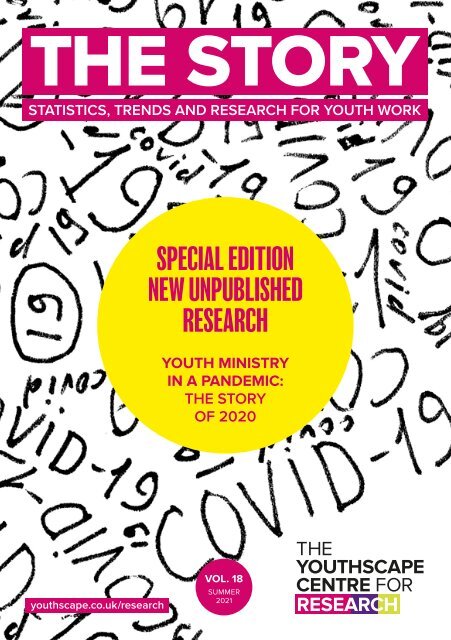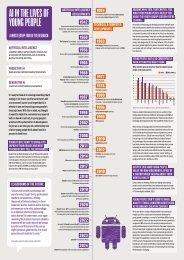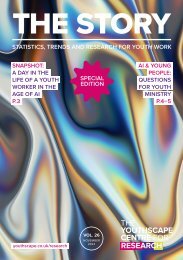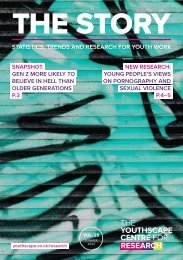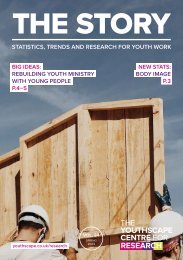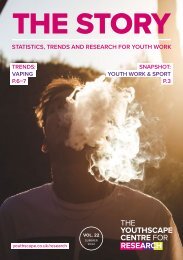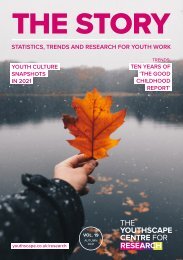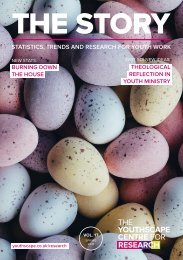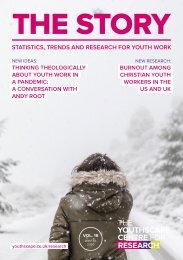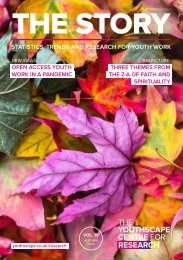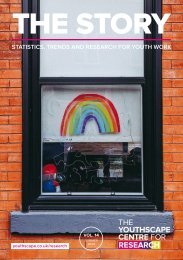The Story Vol 18
Youth ministry in a pandemic: the story of 2020. The challenges and opportunities brought about by Covid-19. Poster: 7 charts on the big picture for youth work.
Youth ministry in a pandemic: the story of 2020. The challenges and opportunities brought about by Covid-19. Poster: 7 charts on the big picture for youth work.
- No tags were found...
Create successful ePaper yourself
Turn your PDF publications into a flip-book with our unique Google optimized e-Paper software.
THE STORY<br />
STATISTICS, TRENDS AND RESEARCH FOR YOUTH WORK<br />
SPECIAL EDITION<br />
NEW UNPUBLISHED<br />
RESEARCH<br />
YOUTH MINISTRY<br />
IN A PANDEMIC:<br />
THE STORY<br />
OF 2020<br />
youthscape.co.uk/research<br />
VOL. <strong>18</strong><br />
SUMMER<br />
2021
WELCOME TO<br />
THE STORY<br />
To be notified about new issues or<br />
subscribe for printed copies visit<br />
www.youthscape.co.uk/research/<br />
the-story<br />
In each issue of <strong>The</strong> <strong>Story</strong> we bring you some<br />
of the latest research related to young<br />
people and youth work. We look for statistics,<br />
research and trends which can shape your<br />
work with young people – informing your<br />
thinking and practice.<br />
In this special issue we are taking over the<br />
whole of <strong>Vol</strong>ume <strong>18</strong> to share the results of a<br />
survey of 501 youth workers, completed at the<br />
end of 2020 by the Centre for Research.<br />
Last autumn, our local youth work team<br />
surveyed a sample of Luton churches and found<br />
that when COVID hit, they lost a significant<br />
number of the young people who had been<br />
regularly engaging – many of whom were still<br />
absent. This raised questions for us about<br />
whether the same pattern was true for the<br />
wider Christian youth work community. So,<br />
we adapted their survey and sent it out to our<br />
networks. <strong>The</strong> findings tell a story about how<br />
the pandemic affected youth ministry over<br />
2020. <strong>The</strong>y don’t tell the whole story – just the<br />
story of these 501 youth workers. However, we<br />
think they are important to share, and would<br />
encourage you to pass this on to parents,<br />
church leaders and anyone else who needs to<br />
hear them. You’ll notice we’ve made the poster<br />
free for this special issue, for that reason.<br />
Special mention goes to Gry Apeland and<br />
her statistical wizardry for analysing a lot of<br />
complicated data!<br />
Thanks for reading,<br />
Lucie Shuker<br />
Director of Research, Youthscape<br />
IN THIS ISSUE:<br />
THE 2020 YOUTH MINISTRY<br />
COVID SURVEY<br />
THE CHALLENGES OF YOUTH<br />
WORK IN A PANDEMIC<br />
CHANGE FOR THE BETTER?<br />
YOUTH WORK OPPORTUNITIES<br />
FROM COVID-19<br />
YOUTH WORK DIAGRAMS<br />
Inside a youth worker’s brain<br />
(2020–2021)<br />
HOW YOUTH MINISTRY IN<br />
2020 WAS IMPACTED BY<br />
THE PANDEMIC IN 7 CHARTS<br />
Research News<br />
In May we launched<br />
a new report, in<br />
partnership with Dr<br />
Naomi Thompson of<br />
Goldsmiths University,<br />
exploring the place<br />
of religion, faith and<br />
spirituality on JNCrecognised<br />
youth<br />
work training courses<br />
across England.<br />
P.3<br />
P.4–5<br />
P.6–7<br />
P.8<br />
REVERSE<br />
You can read the report at:<br />
youthscape.co.uk/research/secular-culture<br />
P.2
THE 2020 YOUTH<br />
MINISTRY COVID<br />
SURVEY<br />
What did you ask?<br />
In the first part of the survey we invited youth<br />
workers to tell us about up to three different<br />
activities they ran and asked how many<br />
young people engaged with each activity pre<br />
lockdown (Jan/Feb 2020), during lockdown 1<br />
(April–June) and post-lockdown 1 (September/<br />
October 2020). We were given information<br />
about 822 different youth work activities.<br />
Who completed the survey?<br />
501 people answered the survey. One of<br />
the limits of the survey is that we only have<br />
demographic data for some of the respondents,<br />
but it shows us that they were most likely to be<br />
employed youth workers, Anglican and to be<br />
based in the South.<br />
• 64% were employed and 36% were<br />
volunteers (n=300)<br />
• 37% were Anglican, 22% Other, 17% Baptist,<br />
10% Pentecostal/charismatic. 4% Catholic,<br />
4% Presbyterian, 4% Methodist and 2% URC<br />
(n=299)<br />
• 38% lived in London and the South East,<br />
14% South West, 9% East of England, 9%<br />
West Midlands, 6% Yorkshire and Humber,<br />
6% Northern Ireland, 6% North West, 4%<br />
Scotland, 4% East Midlands, 2% Wales, 2%<br />
North East<br />
Anything else we need to know?<br />
Not all 501 people answered each question,<br />
so we tell you how many survey respondents<br />
there were per question when we share each<br />
finding. For some of the analysis we wanted to<br />
track what happened to youth work activities<br />
and the numbers of young people engaging in<br />
them over time. In these cases, we excluded<br />
all activities where we didn’t have information<br />
about all three points in time and were left<br />
with a sample of 268 participants who told<br />
us about 409 activities. That’s still a large<br />
enough group to run statistical analysis, but<br />
it’s not representative of the wider youth work<br />
community. This means we can’t generalise from<br />
these findings to all Christian youth workers.<br />
How should we read this, and talk<br />
about it?<br />
Because this was not a representative sample,<br />
it can only really tell us about the people who<br />
took part in the survey. So, the way to share<br />
these headlines would be to say ‘One survey<br />
of Christian youth workers showed that…’<br />
rather than ‘Research shows that…’ It’s a small<br />
difference, but us research pedants will love you<br />
for it :)<br />
So, can I still use it and share it?<br />
Yes! <strong>The</strong>re isn’t lots of data (or any really) on<br />
how COVID has impacted youth ministry. So,<br />
even though this was only meant to be an<br />
internal piece of research, we wanted to share<br />
it with you, and we’d love you to share it with<br />
others. Although we’re now well into 2021, there<br />
will be a need for us to advocate for young<br />
people in the wider church for a long time still.<br />
We hope you can use this data to make the<br />
case that we need to recruit and support youth<br />
workers (paid and voluntary) and keep adapting<br />
the way we love and support teenagers through<br />
this crisis.<br />
P.3
THE CHALLENGES OF<br />
YOUTH WORK IN A<br />
PANDEMIC<br />
<strong>The</strong> largest group of responses related to<br />
the challenges of moving youthwork online<br />
once it was not possible to continue meeting<br />
in person. Our survey showed that 61% of the<br />
youthwork activities happening pre-lockdown<br />
moved online during lockdown 1 and this was<br />
not easy. For many youth workers, an initial<br />
flurry of enthusiasm amongst young people was<br />
quickly dampened as the months of restrictions<br />
dragged on: “Not being able to meet face to<br />
face – very little uptake of Zoom sessions –<br />
they became awkward with only 1 or 2 logging<br />
in, so they were stopped.”<br />
We were told over and over again, that it was<br />
hard to keep young people engaged and<br />
interested in online activities. Zoom fatigue<br />
was partly explained by the natural limits of<br />
what can be done online, rather than in person.<br />
Of course, ‘online’ youth work is more than<br />
Zoom – we know that youth workers tried<br />
gaming, Instagram story devotionals, closed<br />
WhatsApp groups and various other things.<br />
Nevertheless, a clear story emerged of how<br />
challenging it was to sustain engagement.<br />
“Struggling to maintain connection with those<br />
who don’t want to engage online. Unable to<br />
read body language so easily online.”<br />
We were told that this was, in part, because<br />
of the way that teenagers’ entire social and<br />
educational lives had moved online. Many just<br />
reached their limit and dropped away from<br />
online youth work. <strong>The</strong>re were also plenty of<br />
young people who never engaged with, or<br />
liked, online activities in the first place: they<br />
didn’t want to be on camera, and they just didn’t<br />
show up. More practically, there were a group<br />
359 people responded to the question:<br />
“What challenges in your youth<br />
work have you faced due to the<br />
COVID-19 pandemic?”<br />
of young people who it was harder to stay in<br />
contact with, because “Some don’t have access<br />
to digital devices to access the work in the area<br />
that I live in or share devices and can’t come<br />
every week. Some also don’t have their own<br />
space to call from.”<br />
Online youth work was also challenging<br />
because of its format. Youth workers missed<br />
the small interactions that happen in-person,<br />
which build relationship and help them pick up<br />
on how young people are, and what support<br />
they might need. <strong>The</strong>y were aware that young<br />
people’s mental health was under strain but<br />
found it much harder to really know what was<br />
going on, and to be able to respond. As one<br />
person wrote, a challenge was “That you can’t<br />
make someone a hot chocolate or cup of tea<br />
on a tough day.”<br />
Related to this was the more general challenge<br />
of losing contact with young people. Many<br />
people reported a drop in the number of young<br />
people engaging with activities, and this is<br />
reflected in the average loss of 53% across<br />
all activities (see poster). A significant theme<br />
within this loss of contact was losing what youth<br />
workers described as ‘the fringe’, young people<br />
who were not part of church (or whose parents<br />
were not) and those who had been participating<br />
in community-focused youthwork. “Lost contact<br />
with ‘non-church’ members. Those that would<br />
just rock up on a Friday night didn’t log in to<br />
Zoom socials. Many haven’t returned to our<br />
COVID secure youth clubs since lockdown<br />
P.4
either.” One person summed this up succinctly:<br />
“Being a youth worker with no youth is difficult.”<br />
<strong>The</strong>re were a range of other issues youth<br />
workers faced in relation to young people<br />
themselves, that were mentioned less<br />
frequently but were still difficult to respond<br />
to. <strong>The</strong>se included not being able to go into<br />
schools, losing particular groups of young<br />
people (e.g., older youth or girls), and the<br />
challenge of reaching out to, or integrating<br />
new young people while losing others. When<br />
restrictions were lifted, youth workers then<br />
faced new challenges: adjusting to new<br />
guidance for in-person gatherings, the use of<br />
masks and how to manage young people’s<br />
looser interpretations of social distancing rules!<br />
<strong>The</strong>se youth workers also experienced a series<br />
of challenges around the impact of<br />
the pandemic on themselves and their<br />
teams. Some leaders were furloughed during<br />
lockdown 1, and found it hard not being able<br />
to support their young people at such an<br />
important time. Lockdown hit volunteer capacity<br />
quite hard, and many of those who completed<br />
our survey reported their teams struggling<br />
in a range of ways. This included individuals<br />
managing loss of income, working from home,<br />
being furloughed, struggling to adapt to<br />
online work, responsibility for home-schooling,<br />
sheltering, bereavement or personal ill-health.<br />
“<strong>Vol</strong>unteer availability, as some were shielding<br />
and unable to return when lockdown lifted, and<br />
increased workloads meant some were unable<br />
to serve.”<br />
<strong>The</strong>n there was the impact of the general<br />
experience of lockdown and living through<br />
a pandemic in 2020. <strong>The</strong>se youth workers<br />
found it hard to manage so much change and<br />
uncertainty, as well as to understand and take<br />
account of ever-changing restrictions and<br />
government guidance. Some people found<br />
themselves with low motivation for youth work,<br />
and/or carried a sense of failure because they<br />
lost contact with young people, or online youth<br />
work was not thriving. Others felt guilty that<br />
they weren’t doing enough, or that they found<br />
themselves benefitting from a slower pace:<br />
“Feelings of guilt that I wasn’t doing more for<br />
the young people. Losing interest in doing youth<br />
work as time went on”. We heard about youth<br />
workers feeling exhausted and isolated: “Just<br />
having any emotional and mental resources left<br />
to give to the young people, after what’s needed<br />
for family at the moment.”<br />
What does this mean?<br />
It’s clear from these comments that online<br />
youthwork has been a defining experience<br />
for those supporting young people. We<br />
know it has worked really well in some<br />
situations, but it has also been incredibly<br />
challenging for many of you. If you have<br />
struggled with any of the issues described<br />
here, we hope you know you are not alone!<br />
For all the creativity and perseverance<br />
demonstrated in this time, it has still been<br />
incredibly hard.<br />
Aside from validating some of these shared<br />
experiences, we hope you can take from<br />
this the need to recognise the toll taken<br />
by the pandemic, and the need to ask for<br />
support and investment to build youth<br />
ministry back up again. 2021 will have<br />
brought its own, new challenges and<br />
we’re not out of the other side of this yet.<br />
Galatians 6:9 says “Let us not become<br />
weary in doing good, for at the proper time<br />
we will reap a harvest if we do not give<br />
up.” We pray you will find this is true for<br />
you, and your teams.<br />
P.5
CHANGE FOR THE<br />
BETTER? YOUTH WORK<br />
OPPORTUNITIES FROM<br />
COVID-19<br />
350 youth workers responded<br />
to our open question:<br />
“What opportunities in your youth<br />
work have you found due to the<br />
COVID-19 pandemic?”<br />
<strong>The</strong> most popular response was that the<br />
pandemic forced groups to adapt and grow<br />
in their understandings of new technologies<br />
and ways of doing youth work e.g., TikTok,<br />
Instagram, online services, online gaming (143<br />
references). “Zoom has been brilliant!” said one<br />
youth leader (things we never thought we’d<br />
hear?). This was a time for rapid upskilling, “an<br />
opportunity to engage in ways that we never<br />
would have thought of doing before”. For<br />
some, the door to the online world was finally<br />
forced open: “We’ve been trying for a while but<br />
were always told no. However, this gave us no<br />
choice!”<br />
97 people said that the changes resulted in<br />
enhanced group cohesion or engagement.<br />
Groups were sharing more, relationships<br />
(between young people or from leaders to<br />
young people) were going deeper: “Young<br />
people are really enthusiastic about meeting<br />
together and seeing greater levels of<br />
engagement than ever before.” Distance has<br />
its benefits for some: “Some find it easier to be<br />
honest because there’s no-one else actually<br />
there in the room with them.” Alongside this,<br />
many people told us that there had been<br />
more time for 1-1s (e.g., walks, calls, checking<br />
up on individuals more) and small groups (84<br />
references). “I felt we got to know our youth<br />
a lot more and went a lot deeper with them<br />
during the lockdown months.”<br />
With greater engagement and cohesion came<br />
references to an increase in spiritual depth<br />
and discipleship – e.g. more engagement with<br />
prayer or Bible study (58). “Young people<br />
have been more open to praying and Holy<br />
Spirit on Zoom, which has been super fun!”<br />
Another said: “Sharing prayer needs together<br />
has felt significant, too: this didn’t happen<br />
before Covid.” Sometimes engagement,<br />
intimacy and spiritual depth all came together:<br />
“We have prayed more. Running just our<br />
in-house youth Bible group we’ve seen<br />
unexpected growth with some youth club<br />
teenagers joining. We’ve planned more and<br />
seen amazing new leaders emerge. We have<br />
opportunities to set up mentoring. We’re excited<br />
about the future.”<br />
60 youth leaders said that the pandemic was<br />
an opportunity to really evaluate what the<br />
group did and why. With familiar forms of<br />
youth work now unavailable, it was a chance<br />
to reflect, to go back to basics and adjust the<br />
ministry to people’s needs, perhaps reaching<br />
out to those previously missed and doing so in<br />
ways previously unexplored. “It has allowed a<br />
chance to stop and totally reassess all that we<br />
are doing and take an extended break from<br />
the constancy of programming that can make<br />
it difficult to reassess.” This was sometimes<br />
painful but insightful: “We moved our services<br />
online so easily. That’s not right is it? It shouldn’t<br />
have been so easy to capture what we do and<br />
put into a video. It’s highlighted the opportunity<br />
of the church needing to go deeper than<br />
running services.” Covid was a “chance to stop<br />
things that we maybe should have stopped a<br />
P.6
while ago” and “although a horrible, shared<br />
experience... (it) has meant a great opportunity<br />
to reflect together and listen to each other’s<br />
stories and learn together”.<br />
53 said the changes meant they were now<br />
reaching a wider group of individuals, e.g.,<br />
those living further away. <strong>The</strong>re was overlap<br />
here with the 48 who said online youth work<br />
was more accessible and easier to fit in<br />
with young people’s schedules. It was also<br />
often a superior form of gathering for those<br />
with additional needs or more introverted<br />
personality types. Where some usually<br />
struggled with in-person meetings, they now<br />
thrived in online settings: “Young people on<br />
the edges, particularly those on the autistic<br />
spectrum, have really flourished in online youth<br />
work.”<br />
Some youth workers (36) said they now had<br />
improved relationships with parents and<br />
families, and a number felt that online youth<br />
work has empowered young people to take<br />
the lead (34) – particularly where they became<br />
more involved in online services. It wasn’t all<br />
good news of course, 25 said opportunities had<br />
been few or non-existent: “most things we’ve<br />
experimented with haven’t worked”.<br />
<strong>18</strong> leaders said the changes meant they<br />
had more time and resources. <strong>The</strong>y were<br />
less stretched, and so were able to focus on<br />
different things, such as team training, study,<br />
or just having more time to plan. Some felt<br />
online youth work was actually better than inperson<br />
meetings (13), and ten said that working<br />
outside (whether for walks or larger gatherings<br />
like ‘forest church’) had proven beneficial:<br />
“Makes me wonder if perhaps the church<br />
building itself is such a barrier to young people<br />
attending church”. Finally, nine said they’d had<br />
opportunities for working with local schools.<br />
What does this mean?<br />
<strong>The</strong>re’s encouraging news here. <strong>The</strong>re<br />
were 239 references to an increase in<br />
depth during 2020 – be that growing<br />
engagement (97), more time for 1-1’s and<br />
small groups (84), or more time with the<br />
Bible and prayer (58). 1 Covid has exposed<br />
a capacity to adapt, and with that the<br />
possibility that change can bring about<br />
growth, not merely survival. Positive things<br />
have emerged through this disruption, that<br />
probably wouldn’t have done otherwise. Of<br />
course, there hasn’t been one overriding<br />
narrative for all youth workers – we know<br />
there have been enormous challenges and<br />
many have really struggled. <strong>The</strong> survey also<br />
raises new questions. Why did some groups<br />
flourish? <strong>The</strong> pandemic forced adaptation,<br />
but were some youth workers in a better<br />
context or position to ride that wave?<br />
Perhaps more importantly, if a new<br />
capacity has been discovered, it will need<br />
to be cultivated in order to endure. Some<br />
youth workers weren’t able to try online<br />
models until they had no choice. Will the<br />
Church at large still be open to that kind of<br />
innovation once ‘normal’ life creeps back<br />
in? If disruption is a catalyst for growth,<br />
perhaps youth work – and the structures<br />
that support it – will need to learn to invite<br />
disruption and change, even when we’re<br />
not in a pandemic.<br />
1. Some of these were mentioned by the same people, so it is not necessarily the case that this equates to 239 people.<br />
P.7
YOUTH WORK<br />
DIAGRAMS<br />
Inside a youth worker’s<br />
brain (2020–2021)*<br />
A<br />
B<br />
C<br />
Pyjama bottom gland<br />
<strong>The</strong> increasing inability<br />
to wear uncomfortable<br />
clothing on the bottom half<br />
of the body.<br />
Eye-reading area<br />
Understanding what<br />
mumbling young people<br />
are saying behind the<br />
face mask.<br />
One-way-system-thalamus<br />
Sending brain signals when<br />
you are going in the wrong<br />
direction around the church<br />
building.<br />
VIDEO CALL<br />
CORTEX<br />
That’s what<br />
my hair<br />
looks like!<br />
ONLINE GAMES REGION<br />
Am I on<br />
mute?<br />
A<br />
What is<br />
small talk?<br />
Not another<br />
break-out room<br />
MULTIPLE PLAN<br />
CREATOR REGION<br />
PLAN A<br />
PLAN B<br />
PLAN C<br />
PLAN D<br />
SUPER FLEXIBLE<br />
ADAPTOR LOBE<br />
Responding at a<br />
moment’s notice to<br />
the government’s<br />
latest guidance.<br />
MENTAL BANK<br />
of good<br />
youth<br />
work times /<br />
face to face<br />
interactions /<br />
warm hugs to<br />
sustain you.<br />
MISSING<br />
FACE-TO-FACE<br />
YOUTH WORK<br />
CENTRE<br />
SOCIAL MEDIA<br />
SKILL LOBE<br />
Mastering Instagram<br />
only to find that young<br />
people have moved<br />
to TikTok.<br />
C<br />
B<br />
ADDITIONAL<br />
HEAT CENTRE<br />
for outdoor<br />
activities in<br />
sub-zero<br />
temperatures.<br />
INSTINCTIVE<br />
SOCIAL<br />
DISTANCING<br />
GAUGE<br />
For more #youthworkdiagrams<br />
follow us on Twitter @YWresearch<br />
DISAPPOINTMENT<br />
PREVENTION STEM<br />
at having to change<br />
the plan AGAIN.<br />
*Adapted from Melissa Balmain’s ‘Inside a toddler’s brain’<br />
TWITTER POLL:<br />
WHAT DID YOU DO ‘THAT’ SUMMER?<br />
Bute Mills, 74 Bute Street,<br />
Luton, LU1 2EY<br />
hello@youthscape.co.uk<br />
01582 877220<br />
Registered charity no. 1081754.<br />
Registered company no. 3939801<br />
registered in England, a company<br />
limited by guarantee.<br />
Cover photo by Marjan Blan<br />
| @marjanblan on Unsplash.<br />
With no exams to sit, Year 11 has come to a very early end for<br />
many young people we know. What will they do with this long<br />
summer stretching out before them? Well, what did you do, the<br />
summer after taking exams? We asked youth work friends on<br />
twitter how they spent most of their post GCSE months.<br />
WORKING 9–5<br />
(FOR LOW PAY)<br />
DISTURBING<br />
THE PEACE<br />
SLEEPING TILL<br />
NOON<br />
LEARNING FROM<br />
MY MISTAKES<br />
41% 16% 43% 0%<br />
P.8
HOW YOUTH MINISTRY IN 2020 WAS IMPACTED BY THE PANDEMIC IN 7 CHARTS<br />
<strong>The</strong> survey was completed by 501 respondents, who told us about 822 different youth work activities they ran. We asked how many young people engaged with each activity at three time points: pre lockdown (January 2020), during lockdown (March-<br />
June 2020) and post-lockdown (September-October 2020). <strong>The</strong> survey respondents had a choice of reporting up to 3 youth work activities each. <strong>The</strong>se youth workers were not representative of the whole youth work community, so this data should not be<br />
generalised. It tells us the story of what happened to these particular youth workers, not what happened to everyone.<br />
CHART 1<br />
OF THE 822 YOUTH WORK ACTIVITIES<br />
WE WERE TOLD ABOUT…<br />
61%<br />
STOPPED<br />
MOVED ONLINE<br />
4%<br />
35%<br />
REPLACED BY SOMETHING ELSE<br />
CHART 2 CHART 3<br />
ACROSS ALL ACTIVITIES THERE WAS AN AVERAGE LOSS OF 53%<br />
OF YOUNG PEOPLE.<br />
20<br />
<strong>18</strong><br />
16<br />
14<br />
12<br />
10<br />
8<br />
6<br />
4<br />
2<br />
0<br />
19<br />
PRE-LOCKDOWN<br />
6<br />
LOCKDOWN<br />
9<br />
POST-LOCKDOWN<br />
ACTIVITIES THAT MOVED ONLINE WERE STATISTICALLY<br />
MORE LIKELY TO RESTART IN PERSON OR CONTINUE<br />
ONLINE, THAN THOSE THAT STOPPED IN LOCKDOWN 1.<br />
RESTARTED<br />
IN PERSON<br />
(60)<br />
NOT RESTARTED (165)<br />
CONTINUED<br />
ONLINE (21)<br />
STOPPED (273)<br />
OTHER (21)<br />
(25)<br />
NOT RESTARTED<br />
OTHER (21)<br />
REPLACED (28)*<br />
RESTARTED IN PERSON (231)<br />
ONL INE<br />
MO V E D<br />
(4 8 2)<br />
CONTINUED ONLINE (205)<br />
We asked what happened to each activity once<br />
lockdown 1 started in March 2020.<br />
CHART 5<br />
CHURCH GROUPS WERE MORE LIKELY TO MOVE ONLINE THAN OTHER GROUPS.<br />
250<br />
200<br />
150<br />
100<br />
50<br />
0<br />
91<br />
151<br />
51<br />
247<br />
SUNDAY SERVICE CHURCH GROUP COMMUNITY GROUP OTHER<br />
128<br />
We asked how many young people attended each activity at each different timepoint, and this graph<br />
shows us the average number of young people across all different activities.<br />
96<br />
11 5 13<br />
15<br />
11<br />
3<br />
CHART 4<br />
THE AVERAGE NUMBER OF<br />
YOUNG PEOPLE ENGAGING<br />
IN POST-LOCKDOWN<br />
ACTIVITIES CHANGED,<br />
DEPENDING ON WHAT<br />
YOUTH WORKERS DID<br />
IN LOCKDOWN 1.<br />
ONLINE<br />
OTHER FORMAT<br />
RE-STARTED IN PERSON<br />
STOPPED (273)<br />
MOVED ONLINE (482)<br />
REPLACED (28)<br />
We tracked what happened to each of the activities during lockdown 1<br />
(inner circle) and after restrictions were eased (outer circle).<br />
* Of the 28 activities that were replaced during lockdown 1, 14 were restarted in person, 5 were not restarted,<br />
4 moved online and 5 continued as ’other activities’<br />
9<br />
11<br />
14<br />
OTHER<br />
(8)<br />
POST LOCKDOWN<br />
LOCKDOWN 1<br />
Pre-lockdown<br />
there were 19 young<br />
people per activity<br />
on average.<br />
STOPPED<br />
(0)<br />
9 13<br />
10<br />
9<br />
MOVED<br />
ONLINE<br />
(10)<br />
13<br />
11<br />
STOPPED<br />
MOVED ONLINE<br />
REPLACED BY SOMETHING ELSE<br />
We broke down what happened during lockdown by type of activity i.e., regular provision for young people aged 11+ during<br />
Sunday service, and regular activity or group mainly aimed at young people either in the church (e.g., mid-week youth group) or<br />
in the community (e.g., drop-in, detached, schools work).<br />
We tracked how the average number of young people engaging in activities changed, depending on whether activities<br />
stopped, moved online or were delivered in some ‘other’ format. <strong>The</strong> circles in this diagram show the average number of<br />
young people engaging in the different models of post lockdown youth work depending on what happened in lockdown<br />
1. Though the averages shown here are not hugely different, overall significantly more young people attended activities<br />
that were restarted in person, than those that continued online.<br />
CHART 6 CHART 7<br />
COMMUNITY YOUTH WORK EXPERIENCED THE MOST SEVERE LOSS OF YOUNG PEOPLE.<br />
VOLUNTEER-LED YOUTH WORK LOST SIGNIFICANTLY FEWER YOUNG PEOPLE DURING LOCKDOWN.<br />
30<br />
25<br />
20<br />
15<br />
10<br />
5<br />
0<br />
28<br />
15<br />
14<br />
PRE-LOCKDOWN<br />
9<br />
6<br />
3<br />
LOCKDOWN<br />
10<br />
8<br />
POST-LOCKDOWN<br />
20<br />
16<br />
12<br />
8<br />
4<br />
0<br />
19<br />
<strong>18</strong><br />
12<br />
PRE-LOCKDOWN<br />
6<br />
5<br />
LOCKDOWN<br />
9<br />
7<br />
6<br />
POST-LOCKDOWN<br />
SUNDAY SERVICE<br />
CHURCH GROUP<br />
COMMUNITY GROUP<br />
PAID WORKER<br />
VOLUNTEER<br />
MINISTER / CHURCH LEADER<br />
We looked at how the type of activity affected the number of young people engaging at three different points in time.<br />
<strong>The</strong> higher number of young people in community youth work might reflect work in schools, which would have been<br />
heavily impacted by their closure in 2020.<br />
We divided the activities into three groups depending on whether respondents told us that their youth work was mainly led by a paid<br />
worker, volunteer or minister. This chart shows the average number of young people per group at each time point. Paid workers were<br />
over-represented in our sample, so this chart may be showing the impact of furlough on the number of young people they engaged with.<br />
CHART 2: <strong>The</strong> number of activities reported varied at the three time-points as follows: Pre-lockdown – 821, Lockdown – 722 and Post-lockdown – 767. CHART 4: In lockdown 1, 273 activities stopped, 441 moved online and 69 were replaced by ‘other’ activities. Post-lockdown, of those that stopped, 157 were not restarted, 57<br />
restarted in person, 26 went online and 17 were ‘other’ activities (n=257 in total). Of those that moved online, <strong>18</strong> did not restart in person, 228 did restart in person, 201 stayed online and 20 were ‘other’ activities (n=467 activities overall). Of those that were replaced by ‘other’ activities, 1 did not restart, 14 re-started in person, and<br />
4 went online (n=23 in total). CHART 5: A total of 285 activities stopped, 505 moved online and 32 were replaced by other kinds of activity. CHART 6: <strong>The</strong> number of activities reported varied at the three time-points as follow: pre lockdown = 821 activities, lockdown = 722 activities and post lockdown = 767 activities.<br />
CHART 7: 626 activities reported number of young people at all 3 timepoints + type of youth leader.


